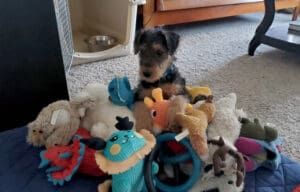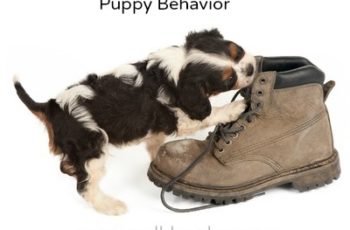
Even if you grew up in a family that had dogs, getting a dog of your own for the first time is a big step. From picking a vet to coming up with a training plan, there’s just so much to figure out! So, once you’ve decided to go for it, what do you need to know as a first time dog owner?
One of the most important things to understand as a first time dog owner is that by bringing a dog into the family, you are taking responsibility for a living being. Far too many dogs end up in rescues or shelters for being “difficult” or “unmanageable,” often in ways that could have been avoided with more knowledge, better training, and good exercise. You can save a lot of heartache by making—and sticking to—a good plan and by consulting with experts promptly when an issue arises that you aren’t sure how to deal with.
In addition to training and exercise, caring for a dog requires regular health care, grooming, a diet plan, and some basic equipment. You will also want to decide where the dog will eat, sleep, and play before she arrives.
First Time Dog Owner Checklist
Before bringing your new dog home, be sure to complete the following checklist:
- Gather all available information about your future dog.
- Discuss introduction plans with family members.
- Schedule a veterinary well-check appointment.
- Select and purchase food.
- Assemble supplies (crate, collar, leash, bowls, etc.).
- Set up the dog’s area with crate, bowls, bed or blanket, and toys.
- Do a complete check of your house and yard.
- Schedule a training class.
Stuff to Buy

If you are a first time dog owner, chances are you won’t have a lot of dog equipment on hand. To get started, it’s a good idea to have the following before you bring your new dog home:
- A collar or harness and leash: You will need a safe way to keep your dog with you in public. Never assume a puppy or dog will just follow along with you—a rock-solid recall takes time and effort to train and, even if you achieve it, there are plenty of places where leashes are required. A well-fitted flat collar or martingale and a soft nylon leash is my go-to. For a look at some of the top products we’ve found, see “The Best Dog-Walking Gear.”
- Bowls for food and water: While it’s not fancy, stainless steel is the best way to go for dog bowls. It’s easy to clean, durable, and will not leach chemicals into the dog’s food or water. As discussed in “Safe Dog Food Bowls (and How to Keep Them That Way),” dog bowls should be cleaned regularly to avoid any buildup of harmful bacteria that can make the dog sick.
- A selection of toys: Toys can be a great source of mental stimulation—along with giving the dog things she is allowed to chew on and play with—but finding the right ones can be tricky. What works for one dog may not work for another, even if they are the same age and breed. I recommend picking up a few to start with and getting to know your new dog before introducing more. If you have a puppy, you will need to consider puppy-appropriate toys. If you end up with an aggressive chewer, be aware that she may be able to rip even sturdy toys into potentially harmful, swallow-able bits in minutes. Be sure to take a toy away if your dog starts to pull it apart.
- An appropriately sized dog crate: While some people prefer not to crate train their dogs, I’m a firm believer in teaching both puppies and older dogs to happily hang out in a crate. When properly used, a crate provides the dog with a place where she can feel safe and can’t get into any trouble while she’s getting used to her new home. Make sure you have a good understanding of how to crate train before attempting to crate your new dog—it’s important that she learns to associate the crate with good things. For more on the types of crates available and how to get the right size for your dog see “What is a Safe Dog Crate?”.
Other items that are less essential but still very helpful include dog beds, brushes, nail trimmers, training treats, a pooper-scooper and clean-up bags for handling dog waste, dog shampoo, baby gates to control access to the house, a dog car seat or seatbelt, and enzyme cleaner for any messes.
Diet
What you feed your dog can have a lasting impact on her overall health and wellbeing. Do some research ahead of time and pick out a good, high-quality food. To get started, read “How to Choose a Dog Food: Factors to Consider” and check out Whole Dog Journal’s assessment of this year’s best dry dog foods and best canned dog foods.
That said, don’t start your dog on her new food immediately. If at all possible, find out what food she has been eating and get a bag of that as well. Dogs can struggle to transition to a new diet so it’s important not to change foods too quickly—switching diets should take seven to ten days. For a guide on how to safely change foods, see “How to Transition Dog Food.”
Like humans, dogs can have allergies or sensitivities to certain ingredients in their food. In addition to obvious gastrointestinal trouble such as vomiting, diarrhea, or constipation, signs that your dog may need a different kind of food can include being overweight or underweight, a dull coat, flatulence, itchiness, hot spots, paw licking, chronic ear infections, listlessness, and hyperactivity. If your dog is experiencing any of those symptoms, talk to your veterinarian to see if he or she thinks it might be food related—especially since many of those indicators can also be symptoms of other ailments.
Healthcare
Speaking of veterinarians, it is important to choose a vet and schedule a checkup for the first week your dog will be with you. Even if the dog is exhibiting no outward indicators of health problems, the veterinarian will be able to do a more thorough check to help identify any hidden issues. Bring any medical records you have for the dog including proof of previous vaccinations. You may also be asked to bring a stool sample which will be used to check for parasites.
Along with verifying the dog’s health, the checkup will officially establish a relationship with the veterinary practice so you’re not scrambling to find someone to see your dog if she gets sick or injured. In addition, a well-check is a good time to ask any questions you might have about your dog’s health needs. Topics to cover with the vet may include:
- Vaccination recommendations for your region
- When you should spay or neuter your dog
- Health concerns to watch out for given the dog’s age, breed, and the area where you are living
- Flea/tick and heartworm prevention medications
- Care plan/next recommended appointment
Training
Training is not just about getting your dog to perform certain behaviors on cue. It is about developing a relationship with your dog so that you can live a good life together. No matter how old your new dog is or where she comes from, you will need a training plan. Especially if you are a first-time dog owner, it is highly recommended that you sign up for a basic obedience class as soon as possible with a good, fear-free dog trainer. There’s no one better to help you learn to speak dog.
You will also need to consider how to go about training your dog not to relieve herself in the house. Even dogs who have previously been house-trained may have accidents in a new environment. Be prepared to deal with the mess—and the learning process—without getting mad at the dog. Housetraining a puppy is usually pretty straightforward, though it takes commitment and constant vigilance in the early stages (see “Puppy Potty Training: Simple, But Not Easy”). Older dogs who have never been housetrained can take more work, depending on why she may be having trouble with it (see “How to Housetrain Your Adult Dog”).
Socialization
While similar to training, socialization is more about getting your new dog used to her environment and the other living beings in it. It is one of the most important things you can do for your dog. While socialization works differently for puppies who are in the process of learning about the world and older dogs who have already developed opinions on it, the basics remain the same:
- Keep experiences positive (food is great for helping this along!).
- Do not force or lure your dog into a situation she doesn’t want to be in. Give her time and support to figure it out.
- Be calm and positive. Dogs can be very good at picking up on what humans are feeling. If you are nervous or uncomfortable, take a break until you are in a better place.
- Start small. A two-minute good experience is much more effective than twenty minutes of practice that ends with something not as great happening.
- Don’t be afraid to call it quits for the day. Sometimes it’s best to take a break, go do something fun, and try another day.
- Get help. If you aren’t sure what to do or don’t seem to be making progress, don’t be afraid to go to a trainer, behaviorist, or veterinarian for help and advice.
For more on how to socialize a dog, see “How to Socialize a Puppy.”
There is one place where you need to be prepared to work on socialization right away. If you have children or other pets, have a plan for making introducing everyone a positive experience. Make sure any kids understand that they will need to go slowly and be gentle with the new dog, no matter how excited they may be. Supervise play closely and make sure the dog can get away from the children—and that they respect her decision to do so—if she feels the need for some quiet time. It is also helpful to engage children in the training process.
When it comes to introducing your new dog to other pets, the rules are similar. Give both pets a safe space to be away from each other, create positive associations and experiences, and don’t rush. For a detailed look at pet introductions, see “How to Introduce a Cat to a Dog.”
Exercise
As a first-time dog owner, it is essential to understand that dogs need daily exercise. For many, a quick walk or meandering around a fenced in yard just isn’t enough. Age, breed, and individual preference all play a part in how much exercise a dog needs with some working breeds (and crossbreeds) needing up to two hours of exercise a day. Before you get a dog, be sure you have the time—or can hire someone—to exercise her.
Along with the fitness-related health benefits, good exercise helps promote good behavior in dogs. An under-exercised dog tends to get bored and frustrated. This often leads her to try to find ways to entertain herself such as chewing on or shredding things, barking at anything interesting passing by the window, and pestering you non-stop.
Grooming
While specific grooming needs are dependent on the dog’s coat type, even short-haired dogs must be groomed. Many grooming tasks can be performed at home with a little research (and practice), but you may want to visit a professional groomer for some of them. To keep a dog healthy, grooming tasks will include:
- Brushing: Brushing is good for any coat type but dogs with thick or long hair will need regular—sometimes daily—attention to keep clean and free of mats. Matted hair can pull painfully on the skin and lead to skin problems if left unaddressed.
- Toenail Trims: On average, dogs require nail trims on a monthly basis. If a dog’s toenails get too long, they can cause difficulty walking or even curl around and grow painfully into the dog’s paw pads.
- Dental Care: Just like with humans, it is recommended that dogs get their teeth brushed daily to help prevent tooth loss and disease. For more information canine dental care, along with how to choose the right toothbrushes and toothpaste for your dog, see “How Often Should You Brush Your Dog’s Teeth?”.
- Haircuts: Some dogs do better with regular haircuts while others should never be shaved. Consult with a professional groomer and see “Should You Shave a Dog?” to determine what is best for your dog.
- Baths: How often you will need to bathe your dog is going to depend a lot on her coat and environment. If you have a soft-coated dog who spends a lot of time digging in the muddy backyard, she’s going to need more baths than a wire-coated dog who mostly walks on sidewalks. For more information on how and when to bathe your dog see “Tips and Techniques for Bathing your Dog.”
How to Take Care of a Dog in the House
Finally, there are a lot of things around the typical household that can cause problems for our dogs. Kids’ toys and small knick-knacks can be choking hazards. Certain plants, cleaning products, and common household chemicals can be poisonous. You’ll need to do some research and conduct a thorough sweep of the house and yard before bringing your new dog home. If a dog can put something in her mouth, assume she will. When I’m puppy-proofing a space, I often sit on the floor to see what catches my eye from dog eye-level.
For a more in-depth discussion of how to turn your home into a safe, healthy environment for your dog see “A Healthy House for Your Dog (and You, Too!)”.


